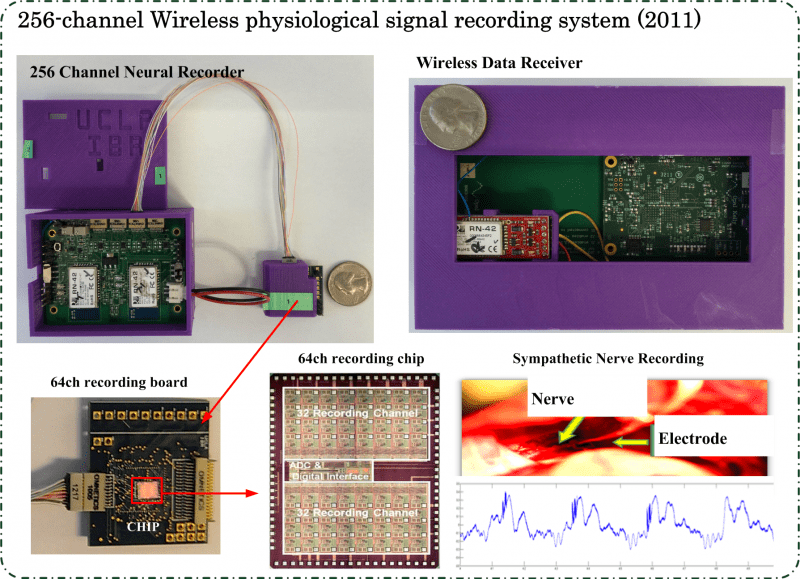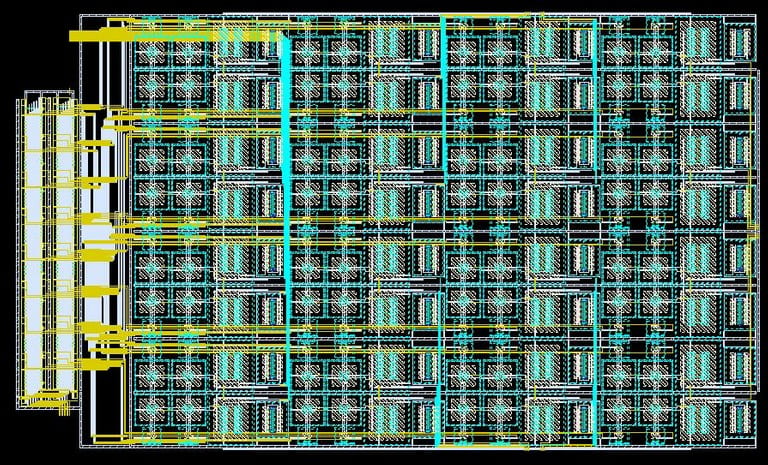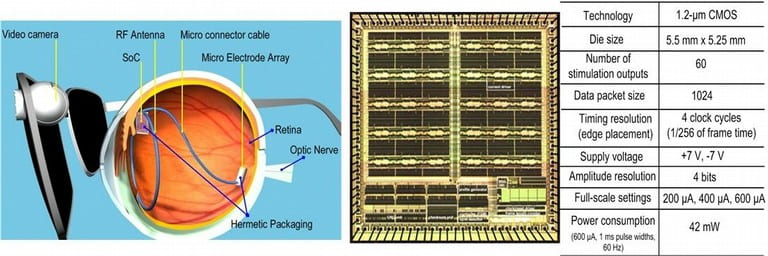
Spinal Cord Prosthesis
We are collaborating with Huntington Medical Research Institutes on intraspinal microstimulation to restore bladder and bowel movement, and sexual function after spinal trauma. The goal is to use intraspinal microstimulation to artificially trigger the reflexes of the visceral organs, after the activation of the spinal circuitry from the brain stem is lost due to spinal cord injury or disease. We are currently designing a 32-channel implantable stimulation chip for implantation in the spinal cord. In order to study the effect of stroke on the spinal circuitry, Dr. Pikov has demonstrated a “virtual stroke” method through reversible cortical inactivation. The goal is to observe the effect of “virtual stroke” on the spinal cord through neural recording, during and after the cortical inactivation. We are currently designing a 48-channel implantable neural recording chip for implantation in the spinal cord.
Next Generation Retinal Prosthesis
We continue our pioneering work on Retinal Prosthesis to restore vision in blind patients with Retinitis Pigmentosa (RP) and Age-related Macular Degeneration (AMD) through developing the next generation retinal implants. The goal of these implants is more than 1000 pixels that would enable facial recognition and independent mobility. The project focuses on delivering power and data to the retinal implant inside the eye and the implant microstimulator electronics which delivers the current pulses to stimulate the retinal layer to elicit visual perception. Since the use of invasive means such as tethering wires results in discomfort and potential infection, a completely wireless approach is used to transfer both power and data. Since the coupling between the external unit consisting of the power transmitter and the power receiver can vary due to the patient’s movements, a closed loop approach is used which varies the transmitted power dynamically to automatically compensate for such movements. We are collaborating with the medical team in University of Southern California and several national laboratories for this project.

Selected Publications
- “Retinal Prosthesis,” J. D. Weiland, W. Liu, and M. S. Humayun, Volume: 7, Pages: 361 – 401, Annual Review of Biomedical Engineering, August 2005.
- “A Core Component for Neuro Stimulus with Telemetry Unit,” W. Liu, M. Humayun, K. Vichienchom, M. Clements, S. DeMarco, E. McGucken, C. Hughes, E. de Juan, J. Weiland, R. Greenberg, Volume: 35, Pages: 1487-1497, IEEE Journal of Solid-State Circuits, October 2000.
Collaborators
- University of Southern California
- California Institute of Technology
- Lawrence Livermore National Laboratory
- Sandia National Laboratory
- Argonne National Laboratory
Power and Data Telemetry
Power and Data Telemetry for Biomimetic Microelectronic Systems
The newly developed systems from NSF BMES ERC will allow bi-directional communication with tissue and by doing so enable implantable/portable microelectronic devices to treat presently incurable diseases such as blindness, paralysis, and certain central nervous system disorders. Our role in the center’s goal is guided by four basic themes and fundamental challenges: power efficiency, bi-directional communication capability, miniaturization, and integration. We are addressing the above challenges through fundamental theory and prototyping of subsystems such as wireless power and data telemetry, microstimulators, neural recording systems, image processing.

Selected Publications
- “Optimization of Coils for Biomedical Applications,” Z. Yang, W. Liu, and E. Basham, IEEE Transactions on Magnetics, Volume: 43, Pages: 3851 – 3860, October 2007.
- “A Non-Coherent PSK Receiver with Interference Canceling for Transcutaneous Neural Implants,” M. Zhou and W. Liu, International Solid-State Circuits Conference, February 2007.
- “Design and Analysis of an Adaptive Transcutaneous Power Telemetry for Biomedical Implants,” G. Wang, W. Liu, M. Sivaprakasam, and G. A. Kendir, IEEE Transactions on Circuits and Systems – I, Volume: 52, Pages: 2109 – 2117, October 2005.
Collaborators
- University of Southern California
- California Institute of Technology



